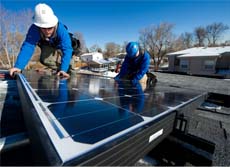Solar week in review: Stormy spring skies
 As with many recent weeks, news from the solar industry and market shows that solar is blooming despite facing pricing uncertainty and other challenges. While some places are enacting new programs to incentivize solar, some companies and projects are being threatened by a variety of factors, from a slow-moving turtle to falling module prices.
As with many recent weeks, news from the solar industry and market shows that solar is blooming despite facing pricing uncertainty and other challenges. While some places are enacting new programs to incentivize solar, some companies and projects are being threatened by a variety of factors, from a slow-moving turtle to falling module prices.
One of the places where falling prices most affected the solar market is Pennsylvania where the state’s solar renewable energy credit (SREC) market slumped because people adopted solar more quickly than expected. The SREC market was limited by how much solar power utilities were required to buy and when there was enough solar, the price of SRECs dropped. Now, the International Brotherhood of Electrical Workers (IBEW) Local 98 and others are supporting HB 1580, which would increase the amount of SRECs that utilities must buy, thereby, increasing the price of the credits, making solar more valuable.
Meanwhile Los Angeles is pushing forward with a solar feed-in tariff (FiT). The city’s CLEAN LA Solar program would create a 150 megawatt feed-in tariff for the city, making it the largest U.S. city to adopt a FiT. FiTs have been essential to the adoption of solar in Germany and elsewhere, although the rapid decline in PV pricing has led to quicker than expected adoption, which has forced governments to lower, and in some cases cease offering the FiT entirely.
Another model to help bring solar to more people is group purchasing agreements. Eugene, Ore., is the latest town to use group purchasing (i.e., bulk buying) to make solar cheaper for its residents. The new Solarize Eugene effort was launched by the nonprofit Resource Innovation Group. Under the model, a preferred contractor is selected to educate the public about solar opportunities and those who want to go solar through the company will be able to get discounted modules based on how many people go solar through the program.
What’s proving to be the most popular options for homeowners to go solar are the third-party PV ownership models. Under such models homeowners don’t pay the cost of owning a PV array up front, they pay it over time, either as a direct lease payment or based on how much power the array produces. And a recent PV Solar Report study of the California market done with SunRun showed that 73.4 percent California homeowners going solar are choosing such options.
There’s no shortage on falling prices for solar, largely because production of silicon-based PV is nearly exceeding demand. But silicon-PV might start to lose market share, according to a new Lux Research report. The report found that silicon carbide and gallium nitride-based PV could comprise up to 22 percent of the PV market by 2020. The materials could be cheaper and more efficient than the current silicon-PV available today. Another novel PV material that’s gaining traction is organic PV. Cambridge’s Cavendish Laboratory recently produced organic PV cells with efficiency levels at 44 percent.
Organic PV offers a cleaner form of solar, but already companies are working to make their PV products as environmentally sustainable as possible. As such, the Solar Energy Industries Association (SEIA) and solar companies are developing the voluntary Solar Industry Commitment to Environmental & Social Responsibility. Under the commitment, participants will make sure they are operating ethically and cleanly. Such efforts will include end-of-life recycling programs and proper handling of hazardous materials.
The desert tortoise again is the centerpiece of environmental debate in California. The imperiled reptile has led Natural Resources Defense Council, Sierra Club and Defenders of Wildlife to sue the Department of the Interior (DOI) over its approval of the 663.5-megawatt Calico Solar Project of Bureau of Land Management-managed land near Barstow, Calif. The organizations contend that the project is on land with too many threatened species, chief among them the desert tortoise.
Image courtesy of NREL



